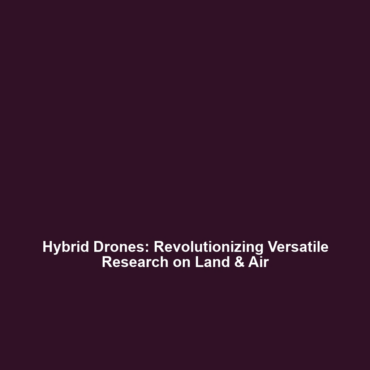Hybrid Drones with Combined Air and Ground Capabilities for More Versatile Research
Introduction
Hybrid drones, equipped with both air and ground capabilities, are revolutionizing the field of scientific research. By combining the efficient aerial mobility of traditional drones with ground maneuvering abilities, these versatile tools enable researchers to access and analyze data in diverse environments. The significance of hybrid drones within the broader category of Drones in Science lies in their ability to perform multi-faceted tasks, streamline data collection, and enhance research outcomes across various scientific disciplines.
Key Concepts
Understanding hybrid drones requires a grasp of several major concepts:
Design and Functionality
Hybrid drones typically incorporate a unique design that allows them to take off and land vertically while also navigating complex terrains. This capability is essential for researchers studying ecological systems, geological formations, and urban development.
Technological Integration
The integration of advanced sensors, GPS technology, and AI-driven algorithms facilitates real-time data collection and processing, making hybrid drones a pivotal component of Drones in Science.
Applications and Real-World Uses
The applications of hybrid drones in scientific research are extensive and impressive:
- Environmental Monitoring: Hybrid drones are used to monitor air and soil quality, track wildlife movements, and assess the impacts of climate change.
- Geological Surveys: Researchers utilize these drones to map geological formations and conduct mineral exploration.
- Urban Studies: Hybrid drones aid in urban planning by analyzing land use patterns and traffic flow.
These practical uses illustrate how hybrid drones with combined air and ground capabilities are integral to advancing the scope of Drones in Science.
Current Challenges
Despite their advantages, several challenges hinder the broader adoption of hybrid drones:
- Technology Limitations: Current battery technology limits flight time and operational range.
- Regulatory Hurdles: Navigating airspace regulations can be complex, impacting research capabilities.
- Data Security: Concerns regarding the privacy of the areas being surveyed affect operational permissions.
These issues highlight the critical challenges of hybrid drones within the Drones in Science domain.
Future Research and Innovations
The future of hybrid drones is bright, with ongoing research focusing on:
- Battery Technology: Developing lightweight and longer-lasting batteries to enhance operational efficiency.
- AI Integration: Innovations in AI for autonomous navigation and data processing will redefine how these drones are utilized.
- Sensor Development: Creating advanced sensors for more comprehensive environmental analysis.
Such breakthroughs will continue to shape the landscape of scientific research, emphasizing the ongoing evolution of hybrid drones and their applications in Drones in Science.
Conclusion
In conclusion, hybrid drones with combined air and ground capabilities represent a significant advancement in the realm of Drones in Science. Their versatility, coupled with ongoing research into overcoming current limitations, positions them as vital tools for future scientific endeavors. As we look forward to further innovations in this field, it is crucial for researchers, policymakers, and technologists to collaborate in harnessing the full potential of hybrid drones. For more insights on drone technology and its applications, check out our other articles on drone advancements and new research methodologies.
